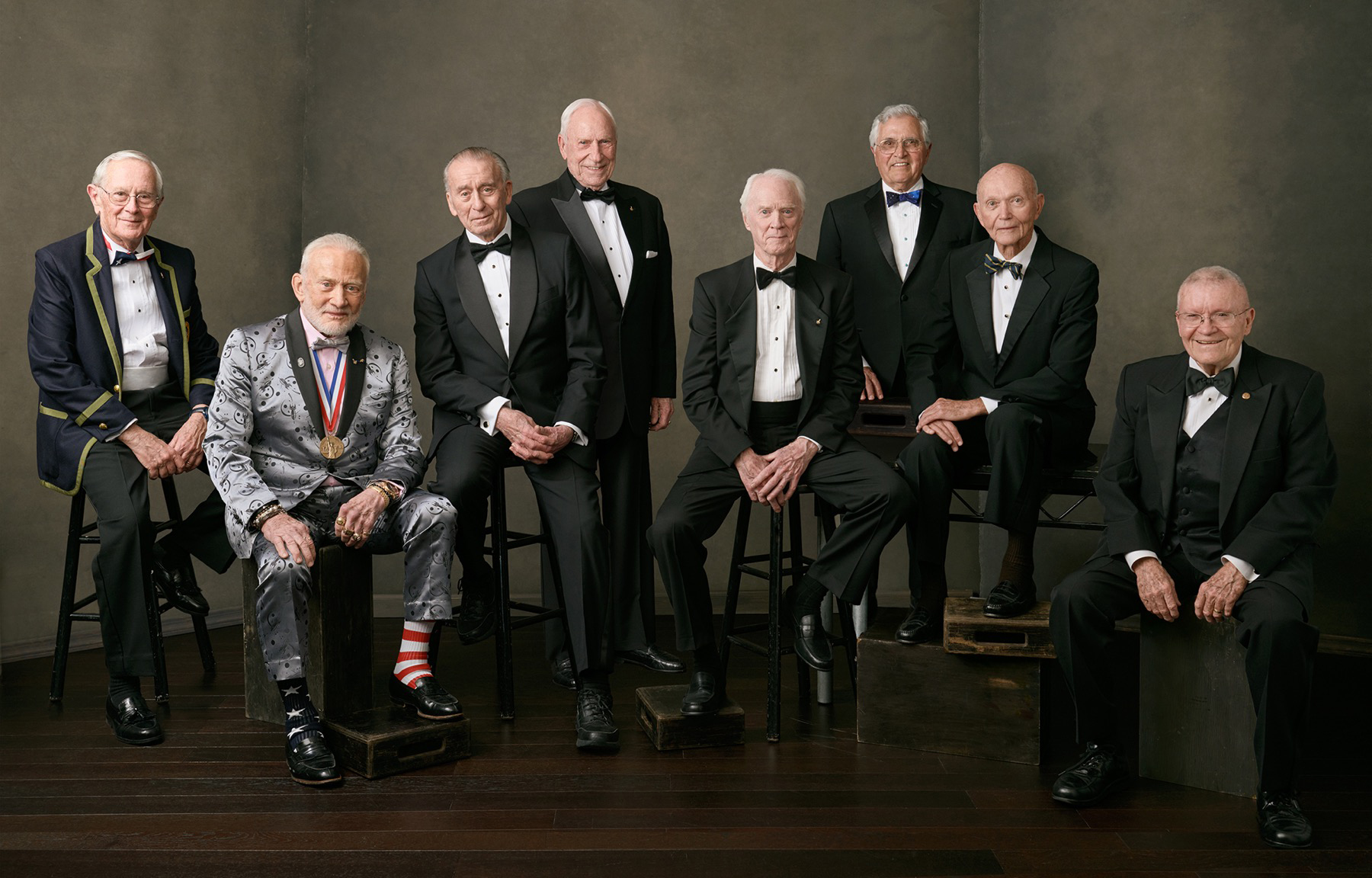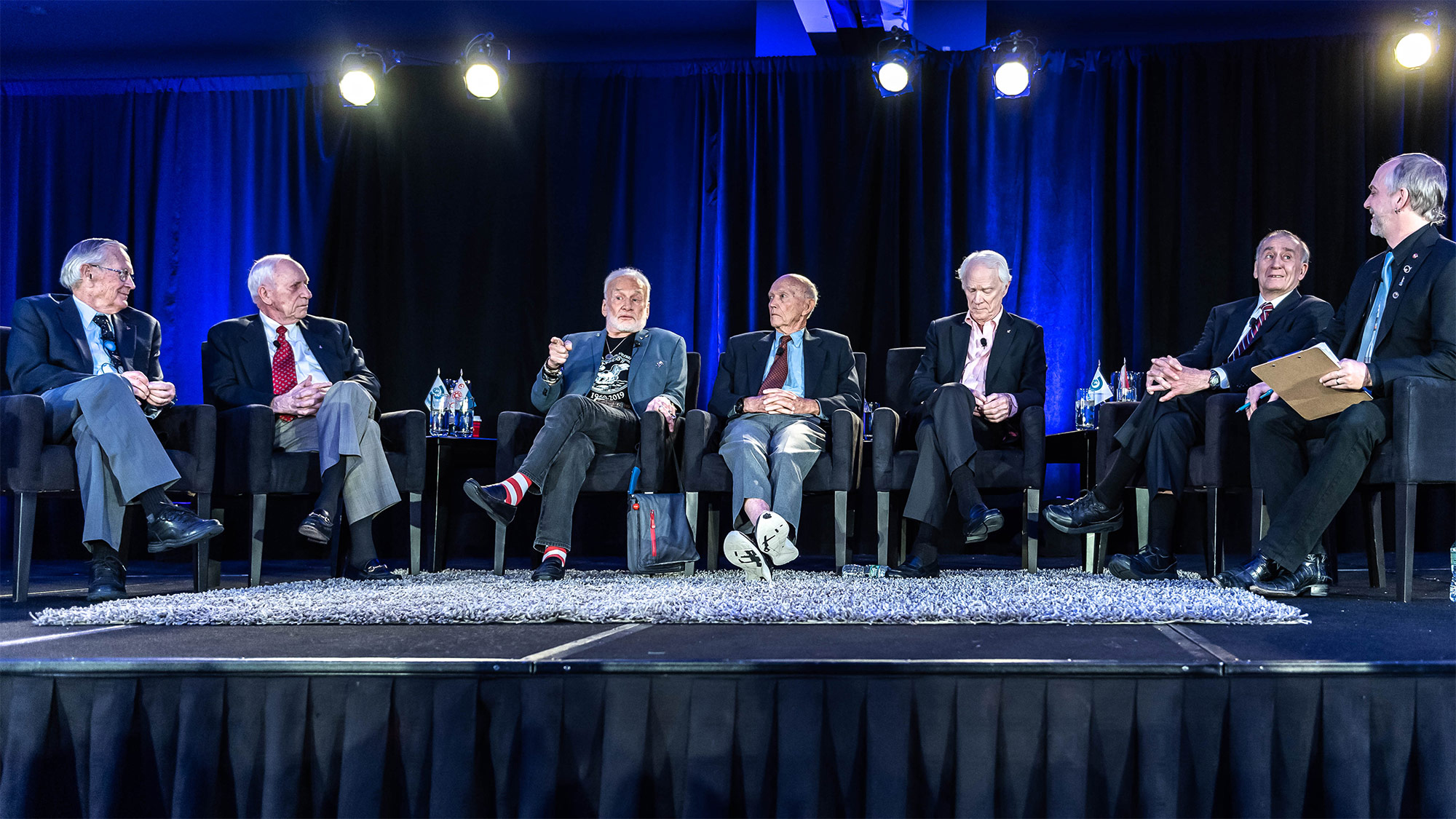The Risk of Apollo: Astronauts Swap Harrowing Tales from NASA's Moon Shots
Here are the times they could have died in space.
NEW YORK — It's no secret that NASA's Apollo missions were risky. Political pressures pushed the hardworking teams at NASA further and faster than what seemed possible.
From the seamstresses in Dover, Delaware, to the engineers and, of course, the astronauts themselves — everyone at NASA had their sights set firmly on the moon. But, while everyone worked to prepare for every possible malfunction or error with the Apollo missions, getting to the moon still presented these astronauts with strange, unusual (and sometimes life-threatening) surprises.
In what may have been the largest gathering of Apollo astronauts in one place this year, a group of the intrepid explorers gathered here for the 115th Explorers Club Annual Dinner on March 16 to receive medals of exploration and look back on their epic missions. The varied group included the likes of Walt Cunningham (Apollo 7); Rusty Schweickart (Apollo 9); Buzz Aldrin and Michael Collins (Apollo 11); Fred Haise (Apollo 13); Al Worden (Apollo 15); Charlie Duke (Apollo 16); and Harrison Schmitt (Apollo 17).
Related: NASA's 17 Apollo Missions in Pictures
An estimated 1,700 Explorers Club members and others gathered to hear the Apollo astronauts speak at the dinner. But before the celebrations commenced, Duke, Worden, Cunningham, Schweickart, Aldrin and Collins gathered before a crowd of 800 guests for a panel moderated by private astronaut Richard Garriott that discussed some of the most hair-raising moments of the Apollo program.
Those brave little white mice

Collins, the apparent comedian of Apollo 11, shared the expected but unnerving reality of having to stay in quarantine after coming back from space.
"What I was worried about was the white mice, 'cause when we came back from the moon, we were gonna be in quarantine for a couple weeks with a whole colony of white mice. And if one of those poor little things didn't do too well, we were in deep trouble — we might have brought back some pathogen," he said. This is just one of the many dangers of spaceflight that aren't as obvious as "what if the rocket blows up."
Get the Space.com Newsletter
Breaking space news, the latest updates on rocket launches, skywatching events and more!
Worden shared a story about the potentially life-threatening situation that his Apollo 15 colleagues, astronauts Jim Irwin and Dave Scott, faced on the moon. Worden remained in lunar orbit in the mission's command module.
"We had a little bit of a problem with Dave Scott and Jim Irwin on the surface,"Worden said. "They had gotten dehydrated, I think that was the big problem. And they were having some heart problems. The big question, and Jim was the worst: Do we expose him to a vacuum in a pressure suit while he's having a little bit of a heart problem? And the answer came back: Yeah, do it." Luckily, Scott and Irwin survived the mission, which included the first-ever deep-space spacewalk (performed by Worden) in spaceflight history.
Related: How Apollo 13's Dangerous Survival Mission Worked (Infographic)
Off-roading in the moon
Duke shared the thrilling but dangerous time he had navigating on Apollo 16's lunar rover.
"The lunar rover only weighed 80 pounds up on the moon, so we got in and strapped in and off we went," Duke said. But, being only 80 pounds, driving the dune buggy-like vehicle around on the moon wasn't like driving around on Earth.
"I felt the ride was real sporty, it bounced a lot. Sometimes both front wheels were off the surface. It was real squirrely. The back end is like driving on ice and breaking loose occasionally," Duke said, adding that because of this, it was sometimes difficult to see exactly where you were about to go — which is pretty scary when you think about all of the craters and canyons on the lunar surface. "But, it was a lot of fun."

Collins and Aldrin shared some of the most harrowing moments of the Apollo program. As Collins describes, while he was in orbit as Armstrongand Aldrin landed on the lunar surface, he had to be ready for any possible scenario.
"I had, on a string around my neck, an 8 by 12 loose-leaf notebook with 18 pages in it. The 18 pages were the various rendezvous possibilities, should things go slightly awry on the moon," Collins said. But, while the crew was prepared for difficult situations, if Armstrong and Aldrin were not able to get off the surface of the moon, there was no way for Collins to save them.
"If they couldn't get off, they were dead men, and I was getting home by myself," he said, adding with a laugh that "I kinda got used to 'em — I preferred the white mice, to tell you the truth."
And, as Aldrin went on to describe, the pair were actually very close to being stranded on the moon.
"We almost did not get off," Aldrin said. Aldrin said that when he and Armstrong went to sleep on the moon, Aldrin "called dibs" on the floor of the craft because it was the only flat surface available. That's when he saw it.
"I laid down on the floor with my head to the right, which is the co-pilot's side, and I'm looking around at the dust that came in, and there's this little black object. Didn't look like it belonged there. Looked a little closer … this was a circuit breaker that was broken," Aldrin said. Then, "I looked at the row of circuit breakers, and it says, 'engine arm.'"
This specific circuit breaker, it just so happened, was essential to getting Neil and Buzz back off the moon.
"You get ready to land, you push that thing in … you get on the surface of the moon, you pull that out. If you wanna come home, you gotta push that thing in again, but it's broken off," Aldrin said, adding that "we didn't know what the hell we could possibly do."
So, of course, he contacted Mission Control back on Earth for help. While Aldrin and Armstrong tried to sleep, their team back home worked toward a solution. But, when they woke up, they were hit with the news that the only real shot they'd have to fix the issue and get the craft off the surface was to try and push it hours before liftoff without the button. Thankfully, after ruling out sticking in their fingers or using metal, ballpoint pens and potentially getting electrocuted, Buzz found his felt-tip pen.
Thankfully, this felt-tip pen did the trick and they left the lunar surface, but "we were coming pretty close to not being able to come home," Aldrin said.
Spaceflight has always been risky, and it will always carry risk. These are just a small handful of the countless stories of death-defying moments in space that these and other astronauts have faced.
- How the Apollo 11 Moon Landing Worked (Infographic)
- Moon Memories: Thousands of Apollo Photos Released Online
- Remembering the Apollo 1 Fire (Infographic)
Follow Chelsea Gohd on Twitter @chelsea_gohd. Follow us on Twitter @Spacedotcom and on Facebook.
Join our Space Forums to keep talking space on the latest missions, night sky and more! And if you have a news tip, correction or comment, let us know at: community@space.com.

Chelsea “Foxanne” Gohd joined Space.com in 2018 and is now a Senior Writer, writing about everything from climate change to planetary science and human spaceflight in both articles and on-camera in videos. With a degree in Public Health and biological sciences, Chelsea has written and worked for institutions including the American Museum of Natural History, Scientific American, Discover Magazine Blog, Astronomy Magazine and Live Science. When not writing, editing or filming something space-y, Chelsea "Foxanne" Gohd is writing music and performing as Foxanne, even launching a song to space in 2021 with Inspiration4. You can follow her on Twitter @chelsea_gohd and @foxannemusic.









